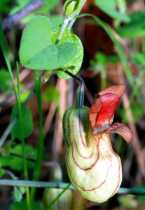| |||||
|
Updated December 14, 2022
With the
Search for Plants
application you can search for wild plants that grow in
California by a variety of criteria.
You can also look up plants through a family name index,
a scientific name index, or a common name index.
On the left hand side of the page, there are links to the other most popular
Calflora web applications.
|
|||||
| Basic Use | |||||
|
Choose some criteria
(such as native grasses that grow in San Diego County)
and press
.
You will go to the
Plant Search Results
page, which shows a summary of each matching plant with photos.
Click on the scientific name of a plant to see the Taxon Report (full details)
about that plant.
| |||||
| Search Criteria | |||||
|
plant name county duration lifeform status community
more . . . elevation below (meters) elevation above (meters) bloom month | |||||
| Result Format | |||||
|
result format | |||||
| Parent Records and Plant Counts | |||||
|
A plant name is referred to as a parent when there are recognized subspecies or varieties.
So for instance,
Frangula californica is considered a parent,
because it has several subspecies (... ssp. crassifolia, ... ssp. cuspidata etc.).
When you search for a parent name, all subspecies and varieties are included in the search results.
Calflora includes parent records as active species because some observations are identified only to the parent level by the contributor. For instance, suppose that a contributor found a population of Fragula californica in the wild, but they are not sure of which subspecies it is, so they identify it only as Frangula californica in their observation record. Because parent records are included in search results, the number of plants returned by a particular search may be high. If you want to compare the floristic biodiversity (the number of wild native plants) of one region vs another, you will get a more realistic count if you omit the parent records. Choose the result format | |||||
| Example Searches | |||||
|
Native ferns with an affinity to serpentine soil, Siskiyou County
|

Aristolochia californica, California pipevine Judy and Barry Breckling |
||||
| Other Plant Search Applications | |||||
|
What Grows Here?
to search for plants based on precise locations
(more precise than just county).
Advanced Search for Plants to search for plants by means of many more criteria other than location (for instance, plants associated with native bees). |
|||||
|
RELEASE NOTES:
v 0.76 December 2021
v 0.61 August, 2015
| |||||